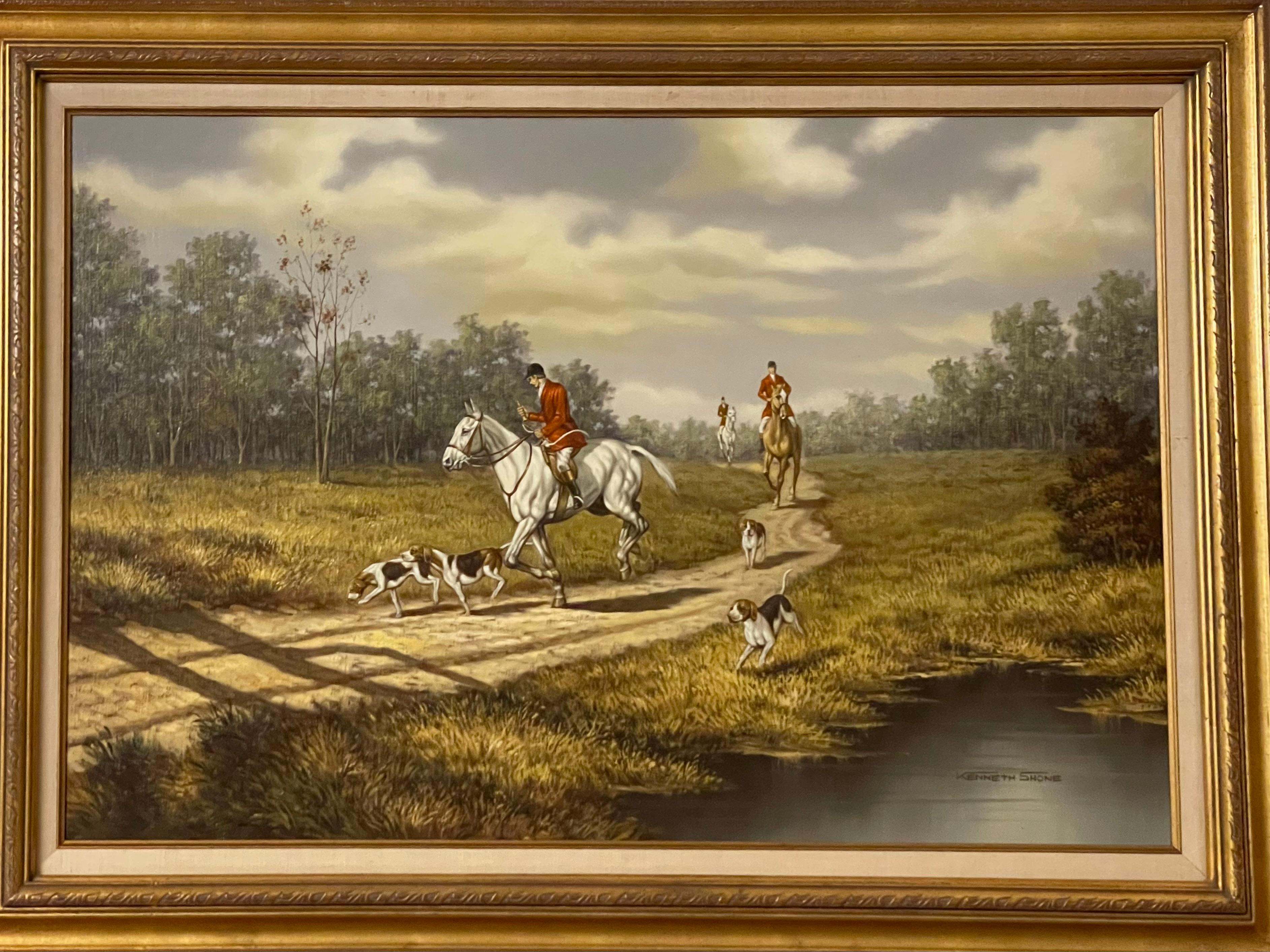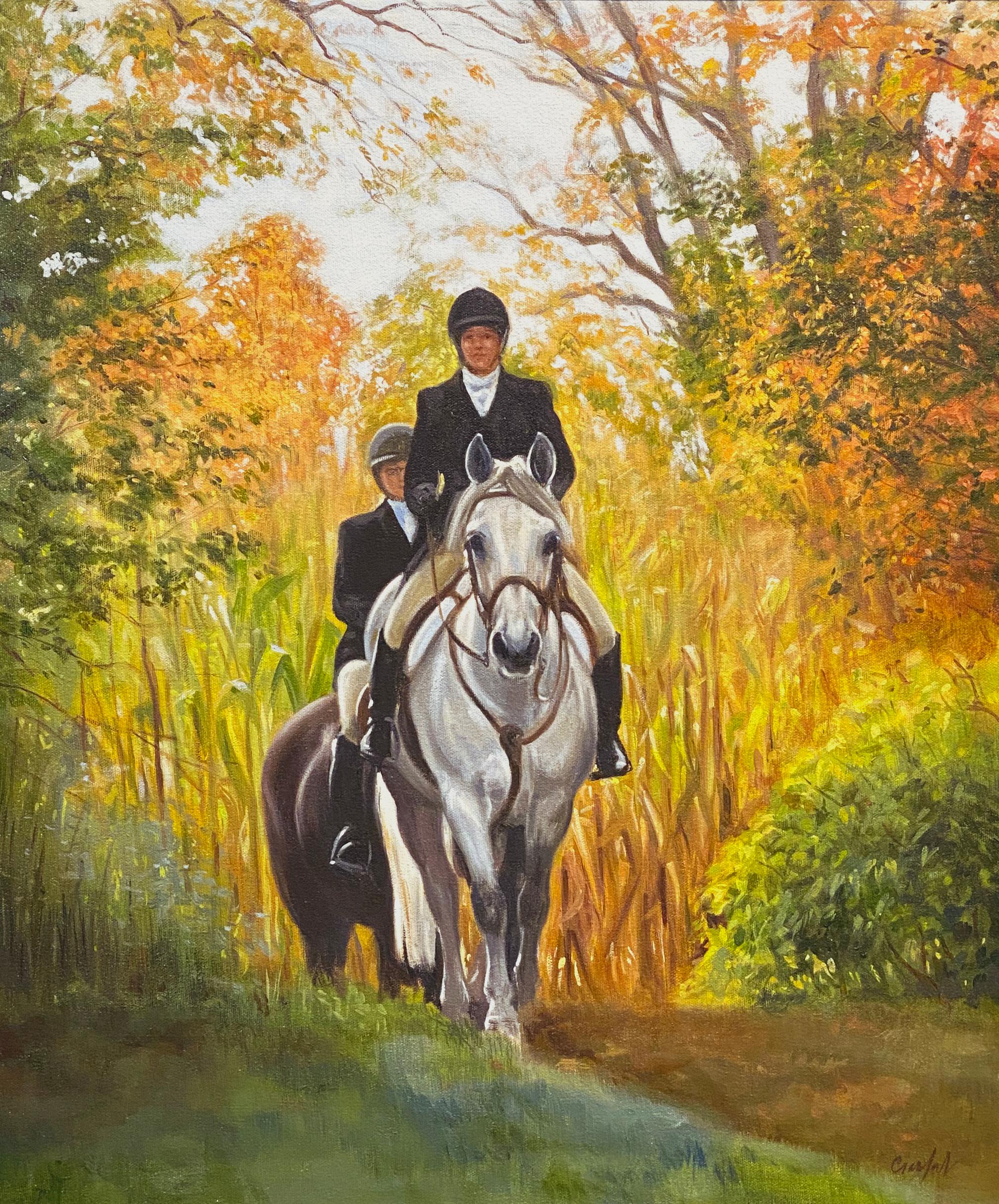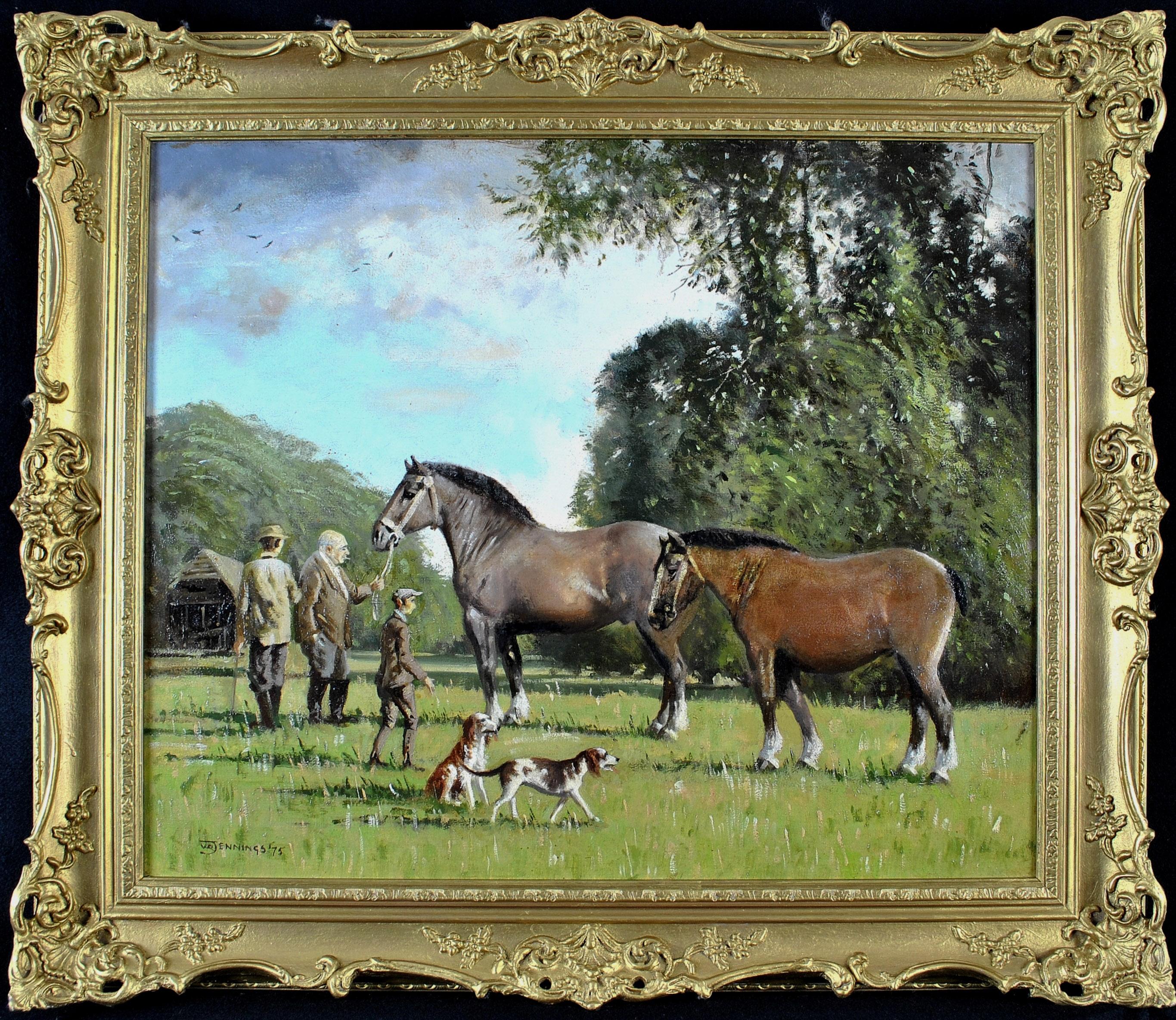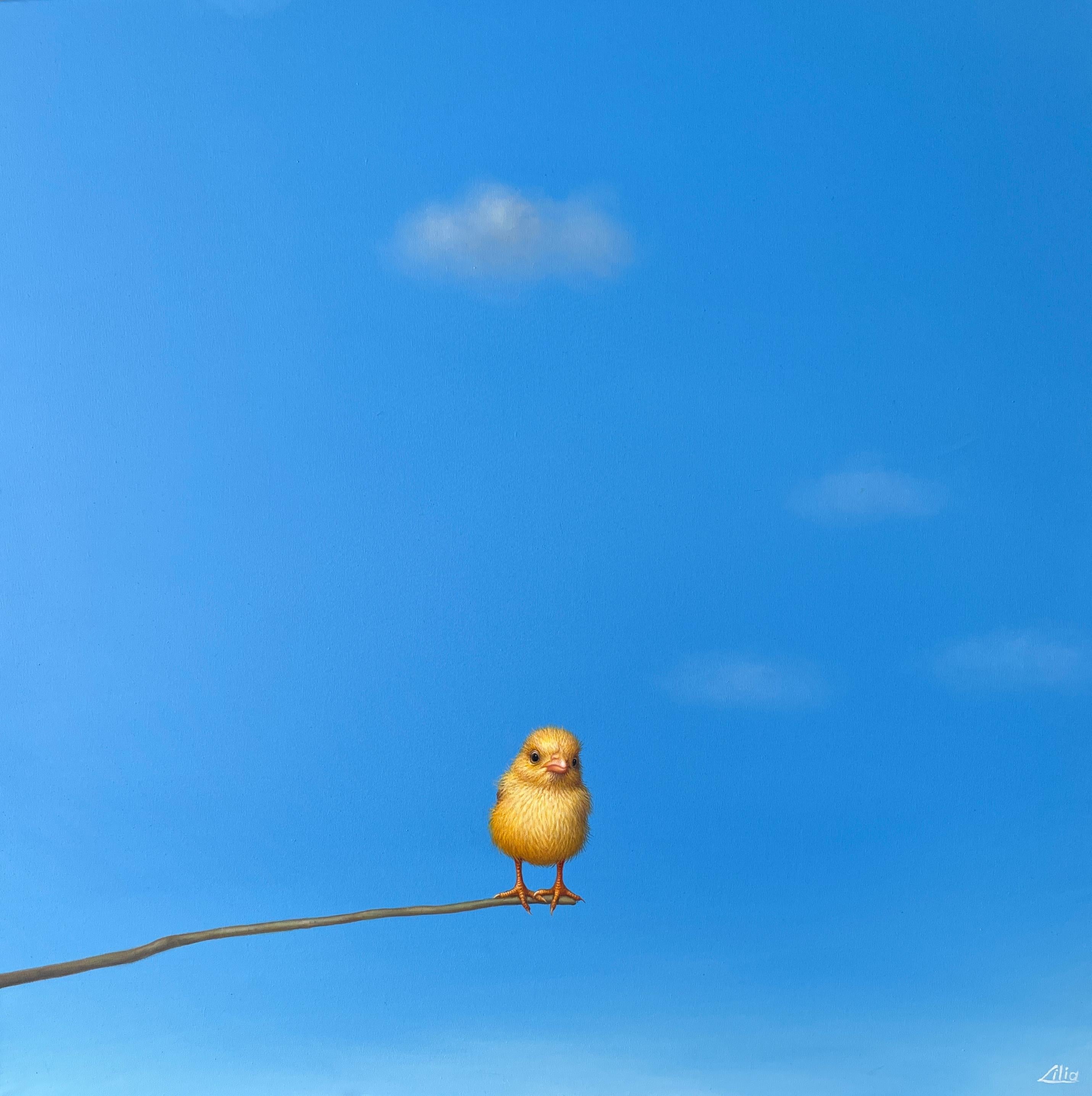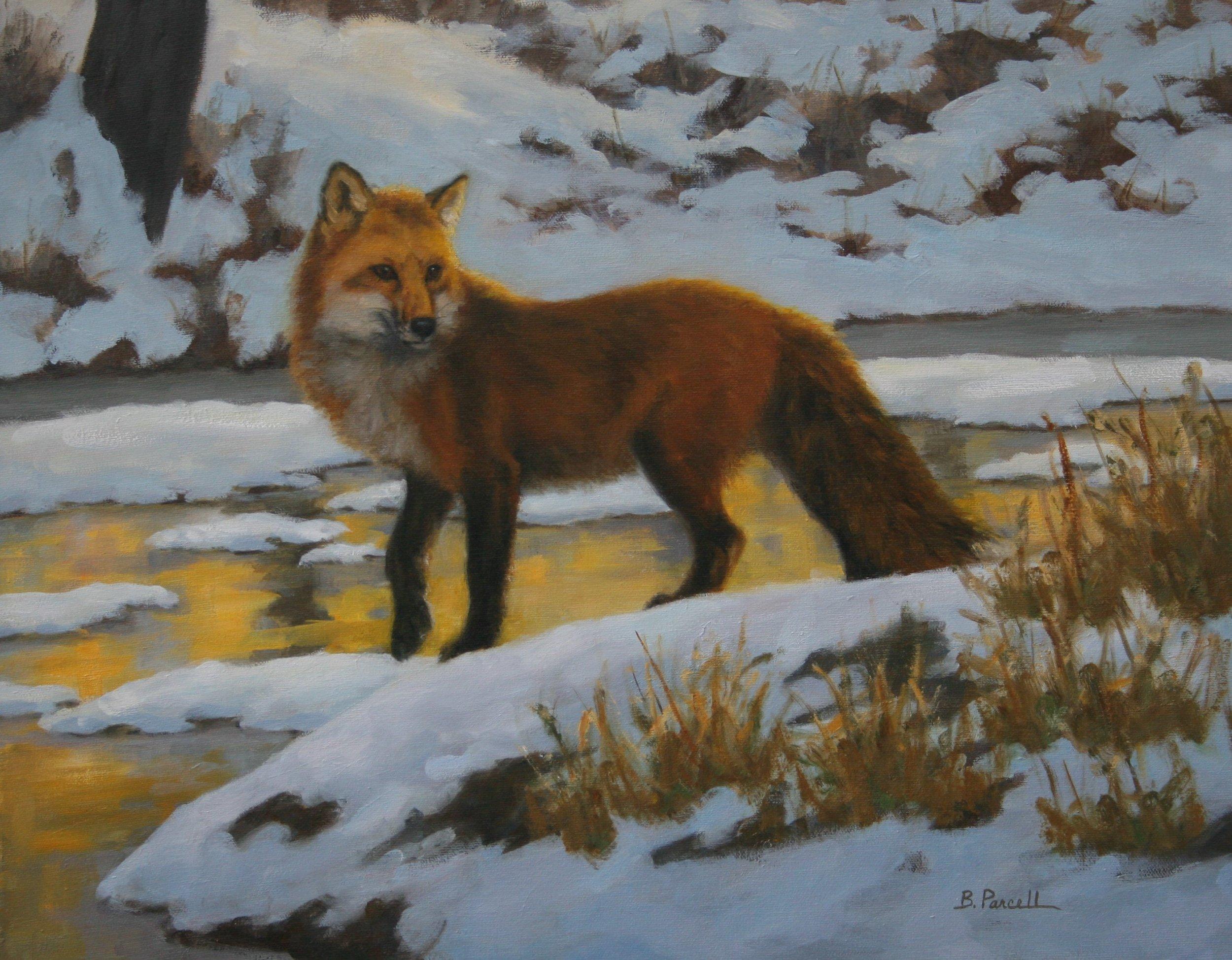Items Similar to Paysage de Neige Dans le Jura, Avec Chevreuil
Video Loading
Want more images or videos?
Request additional images or videos from the seller
1 of 15
Gustave CourbetPaysage de Neige Dans le Jura, Avec Chevreuil1860's
1860's
About the Item
Mid 19th century French oil on canvas of a snow scene in the Jura by Gustave Courbet. Signed bottom right in his characteristic 'ox-blood' red.
Our painting is very similar in composition and style to the work currently held in the Modern Art Museum in Troyes, France, which is dated 1866.
The painting has been in a French collection since the early 20th Century and thence by descent.
UV examination reveals the Courbet signature is contemporary to the time of painting.
An opinion has been given by experts at two major Paris museums that the work is by Courbet but they differed slightly as to the period.
The painting is very similar to snow scenes shown in the Getty Exhibition of 2006, 'Courbet and the Modern Landscape' (see their catalogue)
The technique and colour palette is also very similar to the work sold by Sotheby's in 2019, Paysage de Neige Avec Arbres et Rochers dating to 1865.
(The catalogue note from that sale included:)
'He discovered virgin lands where no one had yet placed a foot, aspects and forms of landscape that one could say were unknown before he painted them...Each time he plunged into the bosom of deep nature, he was like a man who has penetrated a beehive and come out covered with honey'.
The critic Jules-Antoine Castagnary on Courbet:
'A rediscovery unseen in public for over 120 years, Paysage de neige avec arbres et rochers belongs to a small group of winter landscapes of comparable dimensions depicting the same birch trees in the artist's native region of Franche Comté. Other notable compositions include an earlier painting of 1860 in the Cincinnati Art Museum, which features deer and a rocky outcrop to the right, and a work of circa 1865 in the National Galleries of Scotland, Edinburgh, whose composition is close to the present work. Here, as in the Edinburgh work, Courbet explores the sous bois setting through a pure landscape devoid of narrative incident or human presence. In an altogether different form, the motif of the two leaning beech trees in the centre of the composition appeared as early as 1858 in Le Repas de chasse (Wallraf-Richartz-Museum, Cologne).
While Courbet's own mythology suggested an artist who painted quickly with a rough, macho facture, the well preserved surface of the present work reveals how sophisticated Courbet's handling of paint could be. The winter subject allowed Courbet to build layer upon layer of paint over the earth and remnants of the russet foliage through masterful use of the palette knife. As Charlotte Eyerman has written, 'snow itself is Courbet's central fascination in these pictures: it is ephemeral, transmutable, and inherently unstable...As a group, the snowscapes are extremely tactile and emphatically material, and they have a sculptural quality, in terms of both composition and surface.'
The self-proclaimed “proudest and most arrogant man in France,” Gustave Courbet created a sensation at the Paris Salon of 1850–51 when he exhibited a group of paintings set in his native Ornans, a village in the Franche-Comté in eastern France. These works, including The Stonebreakers (1849–50; now lost) and A Burial at Ornans (1849–50; Musèe d’Orsay, Paris) challenged convention by rendering scenes from daily life on the large scale previously reserved for history painting and in an emphatically realistic style. Confronted with the unvarnished realism of Courbet’s imagery, critics derided the ugliness of his figures and dismissed them as “peasants in their Sunday best.”
Courbet’s career was punctuated by scandal, often deliberately courted by the artist himself. Young Women from the Village, set in the outskirts of Ornans, generated further controversy at the Salon of 1852. Critics were nearly unanimous in reproaching Courbet for the “ugliness” of the three young women, for whom the artist’s sisters modelled, and for the disproportionately small scale of the cattle. Moreover, Courbet’s suggestive use of the term demoiselles (young ladies) to denote this trio of young village women further provoked his critics, who took issue with the blurring of class boundaries that the term implied. In the aftermath of the democratic uprisings in the countryside in 1848, Courbet’s depictions of a rural middle class in his Ornans subjects unsettled his Parisian audience at the Salons.
In 1855, Courbet’s monumental canvas, The Painter’s Studio: A Real Allegory Summing Up Seven Years of My Artistic Life (Musée d’Orsay), was rejected by the jury of the Exposition Universelle. Courbet retaliated by mounting his own exhibition in his Pavilion of Realism, built within sight of the official venue, where he displayed, among more than forty other works, The Painter’s Studio. The meaning of Courbet’s unfinished painting remains enigmatic: the figures on the left suggest the various social types that appear in his canvases, while on the right he portrays his friends and supporters. The artist painted himself at the center of this universe, paradoxically painting a landscape within the confines of his studio. The accompanying exhibition catalogue included Courbet’s seminal “Realist Manifesto,” in which he proclaimed his fidelity to subjects drawn from modern life.
During the 1850s, Courbet’s embrace of modernity led him beyond the Ornans subjects that had established his reputation. He captured the café culture of bohemian Paris, painting portraits of its denizens and works inspired by popular café chansons (songs). An avid hunter, Courbet also enjoyed critical and popular success with his hunting scenes, the first of which he exhibited at the Salon of 1857 alongside his portrait of the actor Louis Gueymard. Summering at the fashionable seaside resort of Trouville in 1865, he produced society portraits on commission as well as the more intimate Jo, La Belle Irlandaise, which fuses portraiture and genre painting. The following year, Courbet submitted Woman with a Parrot to the Salon, having vowed to paint a nude that its conservative jury would accept. Like Manet‘s Olympia of 1863 (Musée d’Orsay), Courbet’s nude was unmistakably modern as opposed to the idealized nude “Venuses” and “Eves” by academic artists that proliferated at the Salons. His supporters lauded him for painting “the real, living French woman.”
Landscape played a central role in Courbet’s imagery. From the beginning of his career, he identified himself with the topography of his native Ornans. The distinctive limestone cliffs of the surrounding Jura Mountains provide the backdrop for one of his early self-portraits and recur in Young Ladies of the Village. He developed a repertoire of landscape motifs rooted in his native Franche-Comté, including the Puits-Noir, or Black Well, which inspired a series of paintings that span more than a decade, and the source of the Loue River, a geological curiosity and popular tourist site. In the summer of 1864, he painted at least four variations, on canvases of the same size, of the Loue River as it surges forth from the mouth of the cave in which it originates. He used both palette knife and brush to render the rock formations and foaming surface of the rushing water. Visiting the south of France in 1854, Courbet produced a group of luminous, seemingly infinite views of the Mediterranean. He did not immerse himself fully in painting “landscapes of the sea,” as he preferred to call his seascapes, until subsequent trips to the Normandy coast, undertaken between 1859 and 1869, where he encountered Claude Monet and James McNeill Whistler in 1865. In 1870, Courbet exhibited only seascapes at the Salon—a calculated assertion of his command of the genre.
That same year, Courbet flouted the authority of the state—not for the first time—by publicly refusing the award of the Legion of Honor, declaring his independence from any form of government. Since the time of its creation, Courbet’s realist imagery—from the downtrodden laborers of The Stonebreakers (1849–50) to the rural bourgeoisie of Ornans—had prompted political associations, but the artist’s actual engagement with politics was complex. He called himself a “republican by birth” but did not take up arms during the 1848 Revolution, adhering to his pacifist beliefs. He entered the political arena on the eve of the Paris Commune of 1871 and played an active role in the political and artistic life of this short-lived socialist government. With the demise of the Commune, Courbet was arrested and sentenced to six months imprisonment for his involvement in the destruction of the Vendôme Column, a symbol of Napoleonic authority. In 1873, fearing persecution by the newly installed government, Courbet voluntarily went into exile in Switzerland, where he died in 1877. Through his powerful realism, Courbet became a pioneering figure in the history of modernism.
(With thanks to the Metropolitan Museum of Art, New York)
Courbet's paintings are held in private and national collections throughout the World.
- Creator:Gustave Courbet (1819 - 1877, French)
- Creation Year:1860's
- Dimensions:Height: 19 in (48.26 cm)Width: 22.5 in (57.15 cm)Depth: 2 in (5.08 cm)
- Medium:
- Movement & Style:
- Period:
- Condition:Canvas size 15 inches x 18 inches.There is some wear and losses to the frame. The painting is in good original condition though there may have been some earlier restoration and cleaning.
- Gallery Location:Cotignac, FR
- Reference Number:
About the Seller
5.0
Platinum Seller
These expertly vetted sellers are 1stDibs' most experienced sellers and are rated highest by our customers.
Established in 2000
1stDibs seller since 2020
165 sales on 1stDibs
Typical response time: 1 hour
- ShippingRetrieving quote...Ships From: Cotignac, France
- Return PolicyA return for this item may be initiated within 3 days of delivery.
More From This SellerView All
- Arco de ZocodoverLocated in Cotignac, FRMid Century oil on canvas view of the Moorish arch in the Plaza de Zocodover in Toledo, Spain by Louis Léo Hourdille. The painting is signed and titled to the back of the canvas. Ho...Category
Mid-20th Century Impressionist Landscape Paintings
MaterialsCanvas, Oil
- Large Scale Surrealist Oil on Canvas, 'At the Watering Hole'.Located in Cotignac, FRLarge late 20th century oil on canvas of animals at the watering hole by British artist Derek Carruthers. Signed to the bottom right. A magical, highly colourful and energetic paint...Category
Late 20th Century Surrealist Animal Paintings
MaterialsOil, Canvas
- Impressionist Oil on Canvas, The Salmon Pool, Canonbie, ScotlandLocated in Cotignac, FREarly 20th Century oil on canvas view of a salmon river by Miss D L Murray. The painting is signed bottom left and there is an artist's label with title to th...Category
Early 20th Century Impressionist Landscape Paintings
MaterialsCanvas, Oil
- The Horse Drover, 19th Century Austrian School, Oil on CanvasLocated in Cotignac, FRA mid 19th Century oil on canvas of horses and their drover. The painting is signed MM, dated 1849 and carries a signature to the stretcher Marie Munch. The painting is presented in ...Category
Mid-19th Century Romantic Landscape Paintings
MaterialsOil, Canvas
- Apples, Hommage to Rousseau, large, square, naive work on canvas.Located in Cotignac, FRLarge square French fantasy naive oil on canvas by Jean Henry Brossat. Signed to the front and bearing a title in Russian (?) script to the rear. In a plai...Category
Mid-20th Century Animal Paintings
MaterialsOil, Canvas
- Large Scale Surrealist Oil on Canvas, 'Noah's Ark and the Animals'.Located in Cotignac, FRVery large scale late 20th century oil on canvas of Noah's Ark and the Animals by British artist Derek Carruthers. Signed to the bottom right. A magical, highly colourful and energe...Category
Late 20th Century Surrealist Animal Paintings
MaterialsOil, Canvas
You May Also Like
- Fox HuntLocated in Hillsborough, NCOil painting of horses and hounds set on a country road, this is a contemporary 20th century landscape painting in excellent condition. The color is c...Category
Mid-20th Century Realist Animal Paintings
MaterialsCanvas, Oil
- "The Partridge", 20th Century Oil on Canvas by Spanish Artist Benjamín PalenciaBy Benjamin PalenciaLocated in Madrid, ESBENJAMÍN PALENCIA Spanish, 1894 - 1980 THE PARTRIDGE signed & dated "B. Palencia, 66" (lower right) oil on canvas 25-3/4 x 21-3/8 inches (65 x 54 cm....Category
1960s Realist Animal Paintings
MaterialsCanvas, Oil
- Janet Crawford, "Shimmering Sunlight", 24x20 Equestrian Landscape Oil PaintingBy Janet CrawfordLocated in Saratoga Springs, NYThis equestrian piece, "Shimmering Sunlight", is a 24x20 oil painting on canvas featuring two riders atop their horses riding through the quiet woods in the warm afternoon sunlight. The fall foliage and warm colors make up the trees in the landscape. About the artist: The artwork of Janet Crawford depicts the equestrian lifestyle. Working from her studio in the Berkshires, Janet focuses on classic portraiture of horses, dogs and people. Her original artwork captures the candid moments of the horse world. A trademark of the artist's work is the portrayal of the true nature of the horse. Education: Bachelor of Fine Arts, Cum Laude Concentration: Painting Rhode Island College, 1991 Press: 2000 - Featured artist in Equine Image article, Aug/Sept issue, 2000. Selected Awards: 2012 - National Distinguished Service Award, American Hackney Horse Society 1995 - Horse World Magazine Morgan Artist of the Year 1993 - Harness Tracks of America Art Competition, 2nd Place 1991 - AMHA Art Contest 1st Prize, Morgan Art 1990 - Special Talent Award, Rhode Island College Special Projects: Present - Designer and Painter, Berkshire Carousel Project Present - Program Cover and Horse Show Poster Artist for the Fleet Jumper Classic, Sept. 2000. Present - Poster Artist for the Hampton Classic, Aug. 27-Sept. 3rd. Present - Program Cover Artist since 1996 for UPHA Spring Premiere Present - Illustrator, Horse World Magazine 2012 - Artist for the American Hackney Horse Society Logo 2011 - Cover Artist for the Pfizer Million Dollar Grand Prix Horse Show Program 1999 - Cover Artist, The Chronicle of the Horse 1999 - Cover Artist, Horse America (Horsemen's Yankee Pedlar) 1999 - Exhibition "The Horse in Art" Hartford Fine Art & Frame 1997 - Opening of the Equestrian Collection Gallery 1996 - New England Morgan Horse...Category
2010s Realist Animal Paintings
MaterialsOil, Canvas
- Out of Harness - Large English Oil on Canvas Horses in a Landscape PaintingBy Walter Robin JenningsLocated in Sevenoaks, GBFine large English oil on canvas by Walter Robin Jennings depicting heavy horses out of harness with their owner and stable boy. The artist is very...Category
1970s Realist Animal Paintings
MaterialsCanvas, Oil
- Easter John - original contemporary realist bird and skyscape oil painting artLocated in London, Chelsea"Easter John" by Lilia Mazurkevich welcomes viewers into a serene yet vibrant blue sky, where a singular bird steals the spotlight with its exuberant presence. Perched gracefully on ...Category
21st Century and Contemporary Realist Animal Paintings
MaterialsCanvas, Oil
- Beth Parcell, "Copper Gold", 16x20 Winter Snow Red Fox Landscape Oil PaintingLocated in Saratoga Springs, NYThis snowy scene, "Copper Gold", is a 16x20 winter landscape oil painting featuring a red fox standing in the solitude of the snow covered woods. The fox perches on ice covered rocks...Category
2010s Realist Animal Paintings
MaterialsCanvas, Oil
Recently Viewed
View AllMore Ways To Browse
Le D De Dior
Set De Salon
Deer Handles
Le Cafe
Antique French Knife
Red Sea S
Louis De Belle
Mountain Landscape Swiss
French Court Scene Paintings
Monumental Paint Brush
French Seaside Paintings
Le Cafe De France
Switzerland Mountain Landscape
French Hunting Paintings
Landscape Paintings 19th Century French Unknown
1850portrait Painting
Beech Trees
Deer Art Modern
